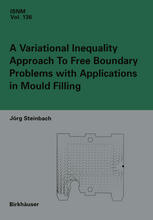

Most ebook files are in PDF format, so you can easily read them using various software such as Foxit Reader or directly on the Google Chrome browser.
Some ebook files are released by publishers in other formats such as .awz, .mobi, .epub, .fb2, etc. You may need to install specific software to read these formats on mobile/PC, such as Calibre.
Please read the tutorial at this link: https://ebookbell.com/faq
We offer FREE conversion to the popular formats you request; however, this may take some time. Therefore, right after payment, please email us, and we will try to provide the service as quickly as possible.
For some exceptional file formats or broken links (if any), please refrain from opening any disputes. Instead, email us first, and we will try to assist within a maximum of 6 hours.
EbookBell Team

5.0
70 reviewsSince the early 1960s, the mathematical theory of variational inequalities has been under rapid development, based on complex analysis and strongly influenced by 'real-life' application. Many, but of course not all, moving free (Le. , a priori un known) boundary problems originating from engineering and economic applica tions can directly, or after a transformation, be formulated as variational inequal ities. In this work we investigate an evolutionary variational inequality with a memory term which is, as a fixed domain formulation, the result of the application of such a transformation to a degenerate moving free boundary problem. This study includes mathematical modelling, existence, uniqueness and regularity results, numerical analysis of finite element and finite volume approximations, as well as numerical simulation results for applications in polymer processing. Essential parts of these research notes were developed during my work at the Chair of Applied Mathematics (LAM) of the Technical University Munich. I would like to express my sincerest gratitude to K. -H. Hoffmann, the head of this chair and the present scientific director of the Center of Advanced European Studies and Research (caesar), for his encouragement and support. With this work I am fol lowing a general concept of Applied Mathematics to which he directed my interest and which, based on application problems, comprises mathematical modelling, mathematical and numerical analysis, computational aspects and visualization of simulation results.